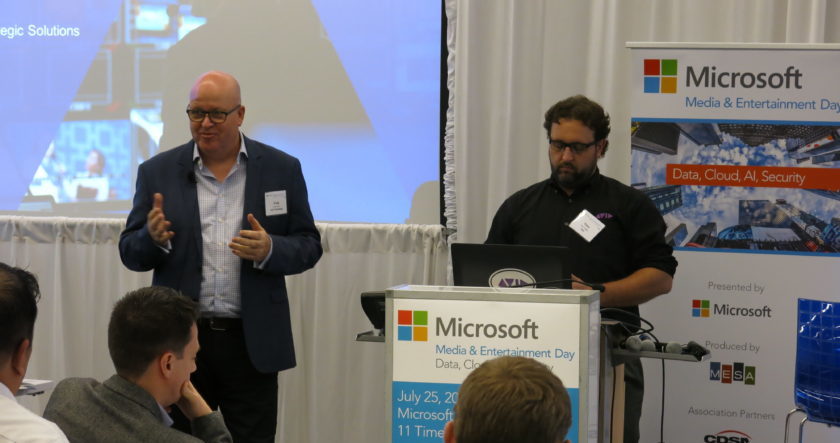M+E Daily

Avid Exec: AI to Have ‘Surprising’ and ‘Exponential Impact’ on Industry
Story Highlights
NEW YORK – Artificial intelligence (AI), including machine learning and video analysis technologies, will have a “surprising” and “exponential impact” on the businesses of Avid Technology and its clients, according to Craig Dwyer, senior director of Avid’s Global Center of Excellence.
“We’ve seen lots of incremental change as we moved from client server to kind of data center and virtualization” services, he said July 25 at the Video in the Microsoft Cloud: Where Collaboration Meets Workflows event at the Microsoft Technology Center. “But now I think we’re going to start to see” that “driving efficiencies at scale suddenly starts to make a lot of sense,” especially among large organizations that have thousands of people using their systems at hundreds of locations, he said.
Dwyer pointed to a few companies at the same event that discussed advanced uses of AI and machine learning, including TiVo and x.news.
“I think what we’re going to start to see is people want to start to understand and predict” any likely scenarios that could impact their operations as they scale their systems, he said. They will then want to also get “not just predictions, but insights” such as steps they could be taking to avoid certain scenarios, he predicted, noting that’s something we’ve already started to see in manufacturing and other supply chain industries that are “ahead of us in some cases.” He added: “I think we’re seeing some patterns that are very common.”
Dwyer also discussed his company’s MediaCentral Platform and why it recently chose Microsoft Azure as its preferred cloud hosting platform for the media production and distribution platform.
“We went through a very thorough evaluation,” and as Avid “worked through all of the different aspects” of the commercial and go-to-market business models, “it became very obvious that, actually in the fields and with our customers, there was a lot of synergy,” he explained, adding: “Certainly the cultural alignment was very, very strong.”
Avid started a “comprehensive strategy” about five years ago as it moved from a “set of tools, applications and sort of client server model into more of a kind of platform model,” he went on to say. “Many of our customers have enjoyed collaborative workflows in the kind of news environment for a long time. But actually what we’re seeing now is people want to bring that to a lot wider kind of content creation lifecycle – so, whether it’s features post production, audio post production” or whatever, he said.
The company’s strategy has been impacted by what he said are some key challenges facing the industry: the increasing rate of content creation, the “exponential growth of distribution and personalized” TV including over-the-top services, and the continued increase in content consumption.
“What’s not growing dramatically” to keep pace with those trends are media tech companies’ budgets, he said. As a result of that, “everyone’s trying to work out how to be very, very efficient and leverage these new opportunities that might be presented, but do that in an economically sustainable way,” and that has “led to a set of common needs,” he said.
As Avid looks at those needs across all its different customer groups, it “informs our product strategy,” and has played a role in its transition to the MediaCentral Platform and overall Avid Everywhere strategy, which is “very much about distributed tools and collaboration,” he said. While moving everything to that platform approach, Avid started to look at that environment, from a cloud perspective, and that’s “what led us to start really evaluating how we would do this with a cloud partner,” he noted.
He went on to say that, “from a services perspective, there are a number of technology trends that are really considerably changing a number of kind of patterns in the way our clients manage and deploy services.” Those trends are “enabling … a whole set of new service models” including hybrid cloud, new distribution models, and a distributed supply chain, he said. Avid clearly sees that its clients “want to remove a lot of the friction between their different systems and actually create a much more fluid connected supply chain,” he said. Building an “ecosystem of partners around the Azure cloud” will create “a lot of efficiency,” he said.
But he added that “consequences” for service providers includes the fact that it’s going to “become easier for people to move projects between service providers.” It’s important for Avid, however, to “build very strong partnerships” with cloud providers and service providers — a “big trend that we can see continuing,” he said.
In addition to that need for strong partnerships, Avid’s “key principles” for its journey to the cloud include the fact that clients are “looking for lots of flexibility,” elasticity and agility – not just “driving to the lowest cost,” he said. In addition, cognitive services can be used to create new workflows and opportunities, and flexible, hybrid deployment options that include cloud and on-premises solutions are not optional, he said.
The Microsoft Azure Stack technology allows users to run on-premises and in the public cloud, and that was a big part of Avid’s evaluation process when it was deciding what company to select as its preferred cloud partner, he said. Avid plans deep integration of its platform with Azure and Avid’s asset management is an example of one area where it’s already running on Azure, he said, adding that Avid services integrated with Azure will start being implemented late this year.
More than 300 people in the media and entertainment sector attended the inaugural Microsoft Media & Entertainment Day, which included the video in cloud track, along with tracks on content protection, metadata, and AI, machine learning and bots.









